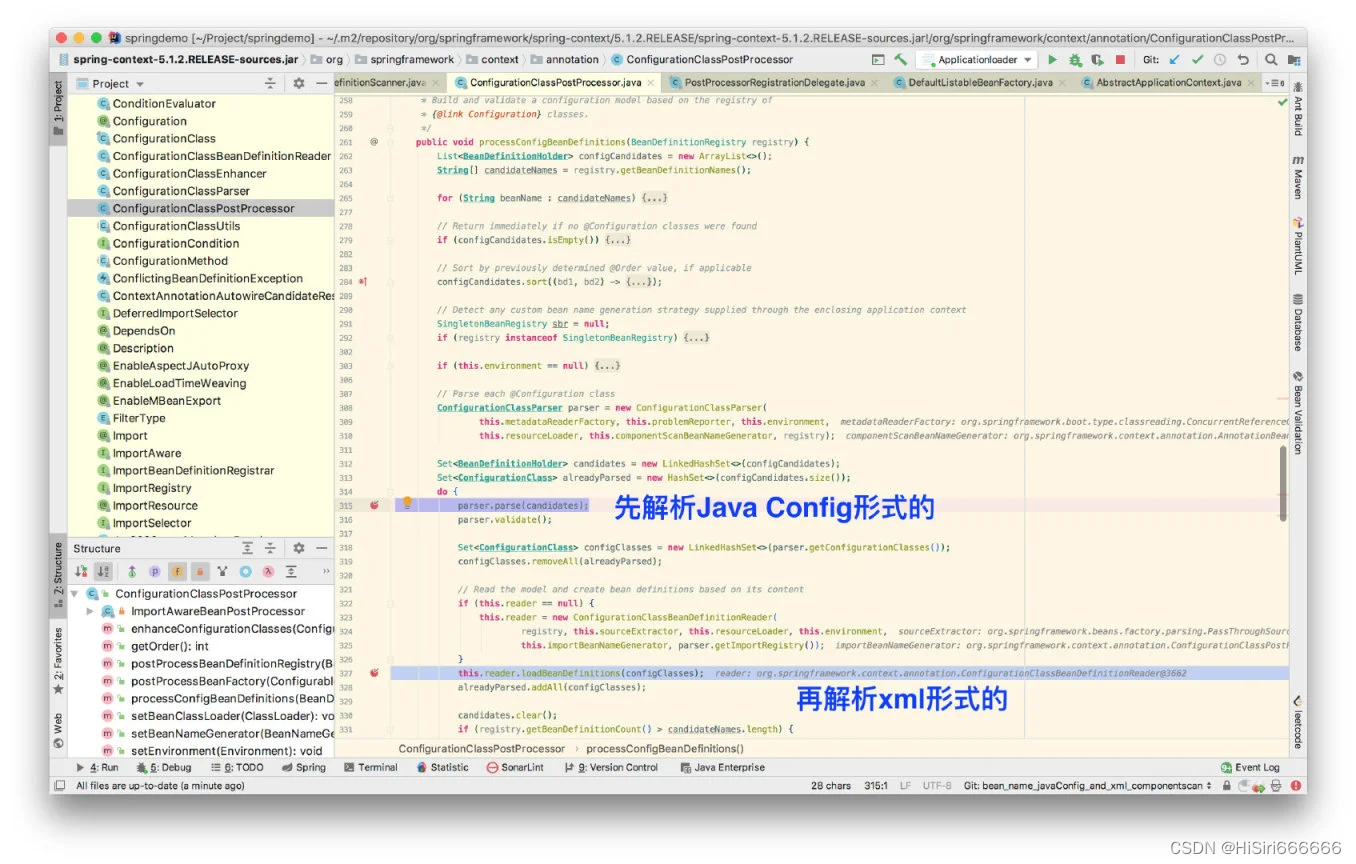📢📢📢📣📣📣
哈喽!大家好,我是「奇点」,江湖人称 singularity。刚工作几年,想和大家一同进步🤝🤝
一位上进心十足的【Java ToB端大厂领域博主】!😜😜😜
喜欢java和python,平时比较懒,能用程序解决的坚决不手动解决😜😜😜
✨ 如果有对【java】感兴趣的【小可爱】,欢迎关注我
❤️❤️❤️感谢各位大可爱小可爱!❤️❤️❤️
————————————————
如果觉得本文对你有帮助,欢迎点赞,欢迎关注我,如果有补充欢迎评论交流,我将努力创作更多更好的文章。

目录
前言
场景 1 两个同名 bean,对应的两个实体类分别是同一个接口的不同实现
场景 2 两个同名 bean,对应的两个类完全没有关系
总结 两个同名 bean,均通过 xml 的 bean 标签声明
场景 3 两个同名 bean,均通过 JavaConfig 的 @Bean 注解声明
场景 4 两个同名 bean,一个通过 xml 的 bean 标签声明,一个通过 JavaConfig 的 @Bean 注解声明。
场景 5 两个同名 bean,均通过 xml 的 context:component-scan 标签扫描发现 bean。
场景 6 两个同名 bean,均通过 Java Config 的注解 @ComponentScan 扫描发现 bean
场景 7 两个同名 bean,一个通过 xml 的 context:component-scan 标签扫描发现,一个通过 Java Config 的注解 @ComponentScan 扫描发现
场景 8 两个同名 bean,一个通过 xml 的 bean 标签声明,一个通过 xml 的 context:component-scan 标签扫描发现
场景 9 两个同名 bean,一个通过 JavaConfig 的 @Bean 注解声明,一个通过 Java Config 的注解 @ComponentScan 扫描发现。
场景梳理
前言
你是否遇到过以下问题:
- 不同的类声明了同一个 bean 名字,有时这两个类实现了同一个接口,有时是完全无关的两个类。
- 多个同名 bean,有的在 xml 中声明,有的以 Java Config 的方式声明。
- xml 文件中,既配了 context:component-scan 标签扫描 bean,又通过 bean 标签声明了 bean,而且两种方式都可以取到同一个 bean。
- Java Config 方式,既配了 @ComponentScan 注解扫描 bean,又通过注解 @Bean 声明 bean,而且两种方式都可以取到同一个 bean。
- xml 和 Java Config 两种方式混合使用,两种方式都可以取到同一个 bean。

那么问题来了,你清楚这几种场景下,Spring 会分别执行什么策略吗?也即:最终取到的 bean 到底是哪一个?
既然有这么多种场景,那我们一一列举,看看到底是怎样执行的,背后的原理又是什么。
开始前,先介绍一下环境:
Spring Boot 2.x版本
我们用的启动类模板:
package application;import org.springframework.boot.SpringApplication;
import org.springframework.boot.autoconfigure.SpringBootApplication;
import org.springframework.boot.autoconfigure.jdbc.DataSourceAutoConfiguration;
import org.springframework.context.ApplicationContext;
import org.springframework.context.annotation.ImportResource;/*** 启动类模板程序,可根据需要添加不同的注解,以便引入对应的上下文。*/@SpringBootApplication(exclude = {DataSourceAutoConfiguration.class})
public class Applicationloader {public static void main(String[] args) {SpringApplication application = new SpringApplication(Applicationloader.class);// Spring Boot版本>=2.1.0时,默认不允许bean覆盖。我们为了研究bean覆盖机制,将它改成允许覆盖。application.setAllowBeanDefinitionOverriding(true);// 启动运行,并获取contextApplicationContext context = application.run(args);// 获取bean,并打印对应的实体类路径Object object = context.getBean("myBean");System.out.println(object.getClass().getName());}
}场景 1 两个同名 bean,对应的两个实体类分别是同一个接口的不同实现
场景描述:两个同名 bean,对应的两个实体类分别是同一个接口的不同实现。
package beans;public interface X {
}package beans;import org.springframework.stereotype.Component;@Component(value = "myBean")
public class XImpl1 implements X {
}package beans;import org.springframework.stereotype.Component;@Component(value = "myBean")
public class XImpl2 implements X {
}再定义 xml 配置文件:
文件名:applicationContext1.xml
<?xml version="1.0" encoding="UTF-8"?>
<beans xmlns="http://www.springframework.org/schema/beans"xmlns:xsi="http://www.w3.org/2001/XMLSchema-instance"xmlns:context="http://www.springframework.org/schema/context"xsi:schemaLocation="http://www.springframework.org/schema/beanshttp://www.springframework.org/schema/beans/spring-beans-3.2.xsdhttp://www.springframework.org/schema/contexthttp://www.springframework.org/schema/context/spring-context-3.2.xsd"><bean id="myBean" class="beans.XImpl1"/>
</beans>文件名:applicationContext2.xml
<?xml version="1.0" encoding="UTF-8"?>
<beans xmlns="http://www.springframework.org/schema/beans"xmlns:xsi="http://www.w3.org/2001/XMLSchema-instance"xmlns:context="http://www.springframework.org/schema/context"xsi:schemaLocation="http://www.springframework.org/schema/beanshttp://www.springframework.org/schema/beans/spring-beans-3.2.xsdhttp://www.springframework.org/schema/contexthttp://www.springframework.org/schema/context/spring-context-3.2.xsd"><bean id="myBean" class="beans.XImpl2"/>
</beans>启动类
package application;import org.springframework.boot.SpringApplication;
import org.springframework.boot.autoconfigure.SpringBootApplication;
import org.springframework.boot.autoconfigure.jdbc.DataSourceAutoConfiguration;
import org.springframework.context.ApplicationContext;
import org.springframework.context.annotation.ImportResource;/*** 启动类模板程序,可根据需要添加不同的注解,以便引入对应的上下文。*/@ImportResource({"classpath:applicationContext1.xml", "classpath:applicationContext2.xml"})
@SpringBootApplication(exclude = {DataSourceAutoConfiguration.class})
public class Applicationloader {public static void main(String[] args) {...}
}执行结果:
beans.XImpl2
如果对调两个 xml 文件的顺序
@ImportResource({"classpath:applicationContext2.xml", "classpath:applicationContext1.xml"})执行结果就会变成:
beans.XImpl1
场景 2 两个同名 bean,对应的两个类完全没有关系
场景描述:两个同名 bean,对应的两个类完全没有关系。
同样,先定义 bean:
package beans;import org.springframework.stereotype.Component;@Component(value = "myBean")
public class Y {
}package beans;import org.springframework.stereotype.Component;@Component(value = "myBean")
public class Z {
}
文件名:applicationContext1.xml
<?xml version="1.0" encoding="UTF-8"?>
<beans xmlns="http://www.springframework.org/schema/beans"xmlns:xsi="http://www.w3.org/2001/XMLSchema-instance"xmlns:context="http://www.springframework.org/schema/context"xsi:schemaLocation="http://www.springframework.org/schema/beanshttp://www.springframework.org/schema/beans/spring-beans-3.2.xsdhttp://www.springframework.org/schema/contexthttp://www.springframework.org/schema/context/spring-context-3.2.xsd"><bean id="myBean" class="beans.Y"/></beans>文件名:applicationContext2.xml
<?xml version="1.0" encoding="UTF-8"?>
<beans xmlns="http://www.springframework.org/schema/beans"xmlns:xsi="http://www.w3.org/2001/XMLSchema-instance"xmlns:context="http://www.springframework.org/schema/context"xsi:schemaLocation="http://www.springframework.org/schema/beanshttp://www.springframework.org/schema/beans/spring-beans-3.2.xsdhttp://www.springframework.org/schema/contexthttp://www.springframework.org/schema/context/spring-context-3.2.xsd"><bean id="myBean" class="beans.Z"/></beans>
执行结果与场景 1 类似。
因此我们可以知道:同名 bean 的覆盖,与具体的类组织方式没有关系。
总结 两个同名 bean,均通过 xml 的 bean 标签声明
场景描述:两个同名 bean,均通过 xml 的 bean 标签声明。其实这就是上面的场景了。
可以看出,最终使用的是后面的 xml 中声明的 bean。其实原因是“后面的 xml 中声明的 bean”把“前面的 xml 中声明的 bean”覆盖了。我们可以看到 Bebug 信息:
Overriding bean definition for bean 'myBean' with a different definition: replacing [Generic bean: class [beans.Z]; scope=; abstract=false; lazyInit=false; autowireMode=0; dependencyCheck=0; autowireCandidate=true; primary=false; factoryBeanName=null; factoryMethodName=null; initMethodName=null; destroyMethodName=null; defined in class path resource [applicationContext2.xml]] with [Generic bean: class [beans.Y]; scope=; abstract=false; lazyInit=false; autowireMode=0; dependencyCheck=0; autowireCandidate=true; primary=false; factoryBeanName=null; factoryMethodName=null; initMethodName=null; destroyMethodName=null; defined in class path resource [applicationContext1.xml]]
这段信息位于源码 org.springframework.beans.factory.support.DefaultListableBeanFactory#registerBeanDefinition:
@Override
public void registerBeanDefinition(String beanName, BeanDefinition beanDefinition)throws BeanDefinitionStoreException {...BeanDefinition existingDefinition = this.beanDefinitionMap.get(beanName);if (existingDefinition != null) {if (!isAllowBeanDefinitionOverriding()) {throw new BeanDefinitionOverrideException(beanName, beanDefinition, existingDefinition);}else if (existingDefinition.getRole() < beanDefinition.getRole()) {...}else if (!beanDefinition.equals(existingDefinition)) {if (logger.isDebugEnabled()) {logger.debug("Overriding bean definition for bean '" + beanName +"' with a different definition: replacing [" + existingDefinition +"] with [" + beanDefinition + "]");}}else {...}this.beanDefinitionMap.put(beanName, beanDefinition);}else {...}if (existingDefinition != null || containsSingleton(beanName)) {resetBeanDefinition(beanName);}
}可以看出,这里首先判断了 allowBeanDefinitionOverriding 属性,也即是否允许 bean 覆盖,如果允许的话,就继续判断 role、beanDefinition 等属性。当 debug 开启时,就会打印出上述的信息,告诉我们 bean 发生了覆盖行为。
如果我们把 ApplicationLoader 中的这行代码删除:
application.setAllowBeanDefinitionOverriding(true);
由于 Spring Boot 2.1.0 及其以上版本默认不允许 bean 覆盖,此时会直接抛 BeanDefinitionOverrideException 异常,上面的源码也有体现。
如果是在 Spring Boot 2.1.0 以下,默认是允许覆盖的,但 setAllowBeanDefinitionOverriding 方法也不存在(它是 2.1.0 加入的,具体可以参见官方文档)。
那我们如果想设置该属性该怎么办呢?此时,我们可以参考 Spring Boot2.1.0 的实现 org.springframework.boot.SpringApplication#prepareContext。通过方法 addInitializers 给 SpringApplication 注册 ApplicationContextInitializer,并复写它的 initialize 方法,通过入参 ConfigurableApplicationContext 获取 DefaultListableBeanFactory,再调用 setAllowBeanDefinitionOverriding 进行设置。示例:
首先,自定义 MyAplicationInitializer:
package application;import org.springframework.beans.factory.config.ConfigurableListableBeanFactory;
import org.springframework.beans.factory.support.DefaultListableBeanFactory;
import org.springframework.context.ApplicationContextInitializer;
import org.springframework.context.ConfigurableApplicationContext;public class MyAplicationInitializer implements ApplicationContextInitializer {@Overridepublic void initialize(ConfigurableApplicationContext context) {ConfigurableListableBeanFactory beanFactory = context.getBeanFactory();if (beanFactory instanceof DefaultListableBeanFactory) {((DefaultListableBeanFactory) beanFactory).setAllowBeanDefinitionOverriding(false);}}
}然后注册自定义的 ApplicationInitializer:
@SpringBootApplication(exclude = {DataSourceAutoConfiguration.class})
public class Applicationloader {public static void main(String[] args) {application.addInitializers(new MyAplicationInitializer);...}
}这样就可以了。
另外,网上还提到重定义 ContextLoader 的方式,可以参考文末列出的第一篇文章。
场景 3 两个同名 bean,均通过 JavaConfig 的 @Bean 注解声明
场景描述:两个同名 bean,均通过 JavaConfig 的 @Bean 注解声明。
bean 的定义不变,我们增加一个配置类,替换之前的 xml 配置文件:
package configuration;import beans.Y;
import beans.Z;
import org.springframework.context.annotation.Bean;
import org.springframework.context.annotation.Configuration;@Configuration
public class MyConfiguration {@Bean(name = "myBean")public Object y() {return new Y();}@Bean(name = "myBean")public Object z() {return new Z();}
}
package application;import configuration.MyConfiguration;
import org.springframework.boot.SpringApplication;
import org.springframework.boot.autoconfigure.SpringBootApplication;
import org.springframework.boot.autoconfigure.jdbc.DataSourceAutoConfiguration;
import org.springframework.context.ApplicationContext;
import org.springframework.context.annotation.Import;@Import(MyConfiguration.class)
@SpringBootApplication(exclude = {DataSourceAutoConfiguration.class})
public class Applicationloader {public static void main(String[] args) {...}
}结果
beans.Y
如果把配置文件中 Y 和 Z 的顺序对调,也即:将其改成这样:
执行结果就会变成:
beans.Z可以看出,最终使用的是位置靠前的 bean。其实原因是“后面的 bean”被忽略了
参考源码 org.springframework.context.annotation.ConfigurationClassBeanDefinitionReader#loadBeanDefinitionsForBeanMethod:
private void loadBeanDefinitionsForBeanMethod(BeanMethod beanMethod) {...// Has this effectively been overridden before (e.g. via XML)?if (isOverriddenByExistingDefinition(beanMethod, beanName)) {if (beanName.equals(beanMethod.getConfigurationClass().getBeanName())) {throw new BeanDefinitionStoreException(beanMethod.getConfigurationClass().getResource().getDescription(),beanName, "Bean name derived from @Bean method '" + beanMethod.getMetadata().getMethodName() +"' clashes with bean name for containing configuration class; please make those names unique!");}return;}...
}可知:如果发现后加载的 bean 可以被 overridden,就会将其忽略。因此最终使用的是先前被加载的 bean。
场景 4 两个同名 bean,一个通过 xml 的 bean 标签声明,一个通过 JavaConfig 的 @Bean 注解声明。
场景描述:两个同名 bean,一个通过 xml 的 bean 标签声明,一个通过 JavaConfig 的 @Bean 注解声明。
我们通过 xml 声明 Y:
<?xml version="1.0" encoding="UTF-8"?>
<beans xmlns="http://www.springframework.org/schema/beans"xmlns:xsi="http://www.w3.org/2001/XMLSchema-instance"xmlns:context="http://www.springframework.org/schema/context"xsi:schemaLocation="http://www.springframework.org/schema/beanshttp://www.springframework.org/schema/beans/spring-beans-3.2.xsdhttp://www.springframework.org/schema/contexthttp://www.springframework.org/schema/context/spring-context-3.2.xsd"><bean id="myBean" class="beans.Y"/></beans>通过 JavaConfig 声明 Z:
package configuration;import beans.Z;
import org.springframework.context.annotation.Bean;
import org.springframework.context.annotation.Configuration;@Configuration
public class MyConfiguration {@Bean(name = "myBean")public Object z() {return new Z();}
}package application;import configuration.MyConfiguration;
import org.springframework.boot.SpringApplication;
import org.springframework.boot.autoconfigure.SpringBootApplication;
import org.springframework.boot.autoconfigure.jdbc.DataSourceAutoConfiguration;
import org.springframework.context.ApplicationContext;
import org.springframework.context.annotation.Import;
import org.springframework.context.annotation.ImportResource;@ImportResource({"classpath:applicationContext.xml"})
@Import(MyConfiguration.class)
@SpringBootApplication(exclude = {DataSourceAutoConfiguration.class})
public class Applicationloader {public static void main(String[] args) {...}
}beans.Y
交换导入的位置
@Import(MyConfiguration.class)
@ImportResource({"classpath:applicationContext.xml"})
两者的上下位置对调一下,输出结果也不变。
因此可以得出结论:当 xml 和 Java Config 均采用注解引入时,最终拿到的 bean 是 xml 文件中声明的。原因是 xml 在 Java Config 之后加载,把 Java Config 声明的 bean 覆盖了。此时我们可以看到 Debug 信息:
Overriding bean definition for bean 'myBean' with a different definition: replacing [Root bean: class [null]; scope=; abstract=false; lazyInit=false; autowireMode=3; dependencyCheck=0; autowireCandidate=true; primary=false; factoryBeanName=configuration.MyConfiguration; factoryMethodName=z; initMethodName=null; destroyMethodName=(inferred); defined in configuration.MyConfiguration] with [Generic bean: class [beans.Y]; scope=; abstract=false; lazyInit=false; autowireMode=0; dependencyCheck=0; autowireCandidate=true; primary=false; factoryBeanName=null; factoryMethodName=null; initMethodName=null; destroyMethodName=null; defined in class path resource [applicationContext.xml]]
场景 5 两个同名 bean,均通过 xml 的 context:component-scan 标签扫描发现 bean。
场景描述:两个同名 bean,均通过 xml 的 context:component-scan 标签扫描发现 bean。
applicationContext.xml 文件:
<?xml version="1.0" encoding="UTF-8"?>
<beans xmlns="http://www.springframework.org/schema/beans"xmlns:xsi="http://www.w3.org/2001/XMLSchema-instance"xmlns:context="http://www.springframework.org/schema/context"xsi:schemaLocation="http://www.springframework.org/schema/beanshttp://www.springframework.org/schema/beans/spring-beans-3.2.xsdhttp://www.springframework.org/schema/contexthttp://www.springframework.org/schema/context/spring-context-3.2.xsd"><context:component-scan base-package="beans"/></beans>由于采用了扫描的方式,我们不用写两个 xml 文件分别声明两个 bean 了,现在一个 applicationContext.xml 文件就可以搞定。
package application;import org.springframework.boot.SpringApplication;
import org.springframework.boot.autoconfigure.SpringBootApplication;
import org.springframework.boot.autoconfigure.jdbc.DataSourceAutoConfiguration;
import org.springframework.context.ApplicationContext;
import org.springframework.context.annotation.ImportResource;@ImportResource({"classpath:applicationContext.xml"})
@SpringBootApplication(exclude = {DataSourceAutoConfiguration.class})
public class Applicationloader {public static void main(String[] args) {...}
}org.springframework.beans.factory.BeanDefinitionStoreException: Unexpected exception parsing XML document from class path resource [applicationContext.xml]; nested exception is org.springframework.context.annotation.ConflictingBeanDefinitionException: Annotation-specified bean name 'myBean' for bean class [beans.Z] conflicts with existing, non-compatible bean definition of same name and class [beans.Y]at org.springframework.beans.factory.xml.XmlBeanDefinitionReader.doLoadBeanDefinitions(XmlBeanDefinitionReader.java:419) ~[spring-beans-5.1.2.RELEASE.jar:5.1.2.RELEASE]at org.springframework.beans.factory.xml.XmlBeanDefinitionReader.loadBeanDefinitions(XmlBeanDefinitionReader.java:336) ~[spring-beans-5.1.2.RELEASE.jar:5.1.2.RELEASE]at org.springframework.beans.factory.xml.XmlBeanDefinitionReader.loadBeanDefinitions(XmlBeanDefinitionReader.java:304) ~[spring-beans-5.1.2.RELEASE.jar:5.1.2.RELEASE]at org.springframework.beans.factory.support.AbstractBeanDefinitionReader.loadBeanDefinitions(AbstractBeanDefinitionReader.java:188) ~[spring-beans-5.1.2.RELEASE.jar:5.1.2.RELEASE]at org.springframework.beans.factory.support.AbstractBeanDefinitionReader.loadBeanDefinitions(AbstractBeanDefinitionReader.java:224) ~[spring-beans-5.1.2.RELEASE.jar:5.1.2.RELEASE]at org.springframework.beans.factory.support.AbstractBeanDefinitionReader.loadBeanDefinitions(AbstractBeanDefinitionReader.java:195) ~[spring-beans-5.1.2.RELEASE.jar:5.1.2.RELEASE]at org.springframework.context.annotation.ConfigurationClassBeanDefinitionReader.lambda$loadBeanDefinitionsFromImportedResources$0(ConfigurationClassBeanDefinitionReader.java:358) ~[spring-context-5.1.2.RELEASE.jar:5.1.2.RELEASE]at java.util.LinkedHashMap.forEach(LinkedHashMap.java:684) ~[na:1.8.0_171]at org.springframework.context.annotation.ConfigurationClassBeanDefinitionReader.loadBeanDefinitionsFromImportedResources(ConfigurationClassBeanDefinitionReader.java:325) ~[spring-context-5.1.2.RELEASE.jar:5.1.2.RELEASE]at org.springframework.context.annotation.ConfigurationClassBeanDefinitionReader.loadBeanDefinitionsForConfigurationClass(ConfigurationClassBeanDefinitionReader.java:144) ~[spring-context-5.1.2.RELEASE.jar:5.1.2.RELEASE]at org.springframework.context.annotation.ConfigurationClassBeanDefinitionReader.loadBeanDefinitions(ConfigurationClassBeanDefinitionReader.java:117) ~[spring-context-5.1.2.RELEASE.jar:5.1.2.RELEASE]at org.springframework.context.annotation.ConfigurationClassPostProcessor.processConfigBeanDefinitions(ConfigurationClassPostProcessor.java:327) ~[spring-context-5.1.2.RELEASE.jar:5.1.2.RELEASE]at org.springframework.context.annotation.ConfigurationClassPostProcessor.postProcessBeanDefinitionRegistry(ConfigurationClassPostProcessor.java:232) ~[spring-context-5.1.2.RELEASE.jar:5.1.2.RELEASE]at org.springframework.context.support.PostProcessorRegistrationDelegate.invokeBeanDefinitionRegistryPostProcessors(PostProcessorRegistrationDelegate.java:275) ~[spring-context-5.1.2.RELEASE.jar:5.1.2.RELEASE]at org.springframework.context.support.PostProcessorRegistrationDelegate.invokeBeanFactoryPostProcessors(PostProcessorRegistrationDelegate.java:95) ~[spring-context-5.1.2.RELEASE.jar:5.1.2.RELEASE]at org.springframework.context.support.AbstractApplicationContext.invokeBeanFactoryPostProcessors(AbstractApplicationContext.java:691) ~[spring-context-5.1.2.RELEASE.jar:5.1.2.RELEASE]at org.springframework.context.support.AbstractApplicationContext.refresh(AbstractApplicationContext.java:528) ~[spring-context-5.1.2.RELEASE.jar:5.1.2.RELEASE]at org.springframework.boot.web.servlet.context.ServletWebServerApplicationContext.refresh(ServletWebServerApplicationContext.java:140) ~[spring-boot-2.1.0.RELEASE.jar:2.1.0.RELEASE]at org.springframework.boot.SpringApplication.refresh(SpringApplication.java:775) ~[spring-boot-2.1.0.RELEASE.jar:2.1.0.RELEASE]at org.springframework.boot.SpringApplication.refreshContext(SpringApplication.java:397) ~[spring-boot-2.1.0.RELEASE.jar:2.1.0.RELEASE]at org.springframework.boot.SpringApplication.run(SpringApplication.java:316) ~[spring-boot-2.1.0.RELEASE.jar:2.1.0.RELEASE]at application.Applicationloader.main(Applicationloader.java:23) [classes/:na]
Caused by: org.springframework.context.annotation.ConflictingBeanDefinitionException: Annotation-specified bean name 'myBean' for bean class [beans.Z] conflicts with existing, non-compatible bean definition of same name and class [beans.Y]at org.springframework.context.annotation.ClassPathBeanDefinitionScanner.checkCandidate(ClassPathBeanDefinitionScanner.java:348) ~[spring-context-5.1.2.RELEASE.jar:5.1.2.RELEASE]at org.springframework.context.annotation.ClassPathBeanDefinitionScanner.doScan(ClassPathBeanDefinitionScanner.java:286) ~[spring-context-5.1.2.RELEASE.jar:5.1.2.RELEASE]at org.springframework.context.annotation.ComponentScanBeanDefinitionParser.parse(ComponentScanBeanDefinitionParser.java:90) ~[spring-context-5.1.2.RELEASE.jar:5.1.2.RELEASE]at 可以看到抛了异常,异常信息告诉我们:发现了两个 bean,但它们不兼容。抛异常的源码位于 org.springframework.context.annotation.ClassPathBeanDefinitionScanner#checkCandidate:
protected boolean checkCandidate(String beanName, BeanDefinition beanDefinition) throws IllegalStateException {if (!this.registry.containsBeanDefinition(beanName)) {return true;}BeanDefinition existingDef = this.registry.getBeanDefinition(beanName);BeanDefinition originatingDef = existingDef.getOriginatingBeanDefinition();if (originatingDef != null) {existingDef = originatingDef;}if (isCompatible(beanDefinition, existingDef)) {return false;}throw new ConflictingBeanDefinitionException("Annotation-specified bean name '" + beanName +"' for bean class [" + beanDefinition.getBeanClassName() + "] conflicts with existing, " +"non-compatible bean definition of same name and class [" + existingDef.getBeanClassName() + "]");
}这段代码执行时机很早(要知道我们现在是允许同名 bean 覆盖的,但显然可以看出,还没有走到判断 allowBeanDefinitionOverriding 属性的地方),扫描出来就检查候选 bean,发现有两个同名 bean,直接报冲突。
场景 6 两个同名 bean,均通过 Java Config 的注解 @ComponentScan 扫描发现 bean
场景描述:两个同名 bean,均通过 Java Config 的注解 @ComponentScan 扫描发现 bean。
package configuration;import org.springframework.context.annotation.ComponentScan;
import org.springframework.context.annotation.Configuration;@ComponentScan(basePackages = "beans")
@Configuration
public class MyConfiguration {@Bean(name = "myBean")public Object y() {return new Y();}@Bean(name = "myBean")public Object z() {return new Z();}
}org.springframework.beans.factory.BeanDefinitionStoreException: Failed to process import candidates for configuration class [application.Applicationloader]; nested exception is org.springframework.context.annotation.ConflictingBeanDefinitionException: Annotation-specified bean name 'myBean' for bean class [beans.Z] conflicts with existing, non-compatible bean definition of same name and class [beans.Y]at org.springframework.context.annotation.ConfigurationClassParser.processImports(ConfigurationClassParser.java:599) ~[spring-context-5.1.2.RELEASE.jar:5.1.2.RELEASE]at org.springframework.context.annotation.ConfigurationClassParser.doProcessConfigurationClass(ConfigurationClassParser.java:302) ~[spring-context-5.1.2.RELEASE.jar:5.1.2.RELEASE]at org.springframework.context.annotation.ConfigurationClassParser.processConfigurationClass(ConfigurationClassParser.java:242) ~[spring-context-5.1.2.RELEASE.jar:5.1.2.RELEASE]at org.springframework.context.annotation.ConfigurationClassParser.parse(ConfigurationClassParser.java:199) ~[spring-context-5.1.2.RELEASE.jar:5.1.2.RELEASE]at org.springframework.context.annotation.ConfigurationClassParser.parse(ConfigurationClassParser.java:167) ~[spring-context-5.1.2.RELEASE.jar:5.1.2.RELEASE]at org.springframework.context.annotation.ConfigurationClassPostProcessor.processConfigBeanDefinitions(ConfigurationClassPostProcessor.java:315) ~[spring-context-5.1.2.RELEASE.jar:5.1.2.RELEASE]at org.springframework.context.annotation.ConfigurationClassPostProcessor.postProcessBeanDefinitionRegistry(ConfigurationClassPostProcessor.java:232) ~[spring-context-5.1.2.RELEASE.jar:5.1.2.RELEASE]at org.springframework.context.support.PostProcessorRegistrationDelegate.invokeBeanDefinitionRegistryPostProcessors(PostProcessorRegistrationDelegate.java:275) ~[spring-context-5.1.2.RELEASE.jar:5.1.2.RELEASE]at org.springframework.context.support.PostProcessorRegistrationDelegate.invokeBeanFactoryPostProcessors(PostProcessorRegistrationDelegate.java:95) ~[spring-context-5.1.2.RELEASE.jar:5.1.2.RELEASE]at org.springframework.context.support.AbstractApplicationContext.invokeBeanFactoryPostProcessors(AbstractApplicationContext.java:691) ~[spring-context-5.1.2.RELEASE.jar:5.1.2.RELEASE]at org.springframework.context.support.AbstractApplicationContext.refresh(AbstractApplicationContext.java:528) ~[spring-context-5.1.2.RELEASE.jar:5.1.2.RELEASE]at org.springframework.boot.web.servlet.context.ServletWebServerApplicationContext.refresh(ServletWebServerApplicationContext.java:140) ~[spring-boot-2.1.0.RELEASE.jar:2.1.0.RELEASE]at org.springframework.boot.SpringApplication.refresh(SpringApplication.java:775) ~[spring-boot-2.1.0.RELEASE.jar:2.1.0.RELEASE]at org.springframework.boot.SpringApplication.refreshContext(SpringApplication.java:397) ~[spring-boot-2.1.0.RELEASE.jar:2.1.0.RELEASE]at org.springframework.boot.SpringApplication.run(SpringApplication.java:316) ~[spring-boot-2.1.0.RELEASE.jar:2.1.0.RELEASE]at application.Applicationloader.main(Applicationloader.java:23) [classes/:na]
Caused by: org.springframework.context.annotation.ConflictingBeanDefinitionException: Annotation-specified bean name 'myBean' for bean class [beans.Z] conflicts with existing, non-compatible bean definition of same name and class [beans.Y]at org.springframework.context.annotation.ClassPathBeanDefinitionScanner.checkCandidate(ClassPathBeanDefinitionScanner.java:348) ~[spring-context-5.1.2.RELEASE.jar:5.1.2.RELEASE]at org.springframework.context.annotation.ClassPathBeanDefinitionScanner.doScan(ClassPathBeanDefinitionScanner.java:286) ~[spring-context-5.1.2.RELEASE.jar:5.1.2.RELEASE]at org.springframework.context.annotation.ComponentScanAnnotationParser.parse(ComponentScanAnnotationParser.java:132) ~[spring-context-5.1.2.RELEASE.jar:5.1.2.RELEASE]at org.springframework.context.annotation.ConfigurationClassParser.doProcessConfigurationClass(ConfigurationClassParser.java:287) ~[spring-context-5.1.2.RELEASE.jar:5.1.2.RELEASE]at org.springframework.context.annotation.ConfigurationClassParser.processConfigurationClass(ConfigurationClassParser.java:242) ~[spring-context-5.1.2.RELEASE.jar:5.1.2.RELEASE]at org.springframework.context.annotation.ConfigurationClassParser.processImports(ConfigurationClassParser.java:589) ~[spring-context-5.1.2.RELEASE.jar:5.1.2.RELEASE]... 15 common frames omitted可以看到抛了异常,异常信息告诉我们:发现了两个 bean,但它们不兼容。
同时,我们可以看到,场景 5和 6 类似,抛的异常相同。但由于场景 5 是 xml 解析,场景 6 是 Java Config 解析,因此具体的堆栈信息有些差异。
场景 7 两个同名 bean,一个通过 xml 的 context:component-scan 标签扫描发现,一个通过 Java Config 的注解 @ComponentScan 扫描发现
场景描述:两个同名 bean,一个通过 xml 的 context:component-scan 标签扫描发现,一个通过 Java Config 的注解 @ComponentScan 扫描发现。
文件名:applicationContext.xml 通过 xml 扫描 Y:
<?xml version="1.0" encoding="UTF-8"?>
<beans xmlns="http://www.springframework.org/schema/beans"xmlns:xsi="http://www.w3.org/2001/XMLSchema-instance"xmlns:context="http://www.springframework.org/schema/context"xsi:schemaLocation="http://www.springframework.org/schema/beanshttp://www.springframework.org/schema/beans/spring-beans-3.2.xsdhttp://www.springframework.org/schema/contexthttp://www.springframework.org/schema/context/spring-context-3.2.xsd"><context:component-scan base-package="beans" use-default-filters="false"><context:include-filter type="assignable" expression="beans.Y"/></context:component-scan></beans>通过 JavaConfig 扫描 Z:
package configuration;import beans.Z;
import org.springframework.context.annotation.ComponentScan;
import org.springframework.context.annotation.Configuration;
import org.springframework.context.annotation.FilterType;@ComponentScan(basePackages = "beans",includeFilters = @ComponentScan.Filter(type = FilterType.ASSIGNABLE_TYPE, classes = Z.class), useDefaultFilters = false)
@Configuration
public class MyConfiguration {
}@ImportResource({"classpath:applicationContext.xml"})
@Import(MyConfiguration.class)
@SpringBootApplication(exclude = {DataSourceAutoConfiguration.class})
public class Applicationloader {public static void main(String[] args) {...}
}org.springframework.beans.factory.BeanDefinitionStoreException: Unexpected exception parsing XML document from class path resource [applicationContext.xml]; nested exception is org.springframework.context.annotation.ConflictingBeanDefinitionException: Annotation-specified bean name 'myBean' for bean class [beans.Y] conflicts with existing, non-compatible bean definition of same name and class [beans.Z]at org.springframework.beans.factory.xml.XmlBeanDefinitionReader.doLoadBeanDefinitions(XmlBeanDefinitionReader.java:419) ~[spring-beans-5.1.2.RELEASE.jar:5.1.2.RELEASE]at org.springframework.beans.factory.xml.XmlBeanDefinitionReader.loadBeanDefinitions(XmlBeanDefinitionReader.java:336) ~[spring-beans-5.1.2.RELEASE.jar:5.1.2.RELEASE]at org.springframework.beans.factory.xml.XmlBeanDefinitionReader.loadBeanDefinitions(XmlBeanDefinitionReader.java:304) ~[spring-beans-5.1.2.RELEASE.jar:5.1.2.RELEASE]at org.springframework.beans.factory.support.AbstractBeanDefinitionReader.loadBeanDefinitions(AbstractBeanDefinitionReader.java:188) ~[spring-beans-5.1.2.RELEASE.jar:5.1.2.RELEASE]at org.springframework.beans.factory.support.AbstractBeanDefinitionReader.loadBeanDefinitions(AbstractBeanDefinitionReader.java:224) ~[spring-beans-5.1.2.RELEASE.jar:5.1.2.RELEASE]at org.springframework.beans.factory.support.AbstractBeanDefinitionReader.loadBeanDefinitions(AbstractBeanDefinitionReader.java:195) ~[spring-beans-5.1.2.RELEASE.jar:5.1.2.RELEASE]at org.springframework.context.annotation.ConfigurationClassBeanDefinitionReader.lambda$loadBeanDefinitionsFromImportedResources$0(ConfigurationClassBeanDefinitionReader.java:358) ~[spring-context-5.1.2.RELEASE.jar:5.1.2.RELEASE]at java.util.LinkedHashMap.forEach(LinkedHashMap.java:684) ~[na:1.8.0_171]at org.springframework.context.annotation.ConfigurationClassBeanDefinitionReader.loadBeanDefinitionsFromImportedResources(ConfigurationClassBeanDefinitionReader.java:325) ~[spring-context-5.1.2.RELEASE.jar:5.1.2.RELEASE]at org.springframework.context.annotation.ConfigurationClassBeanDefinitionReader.loadBeanDefinitionsForConfigurationClass(ConfigurationClassBeanDefinitionReader.java:144) ~[spring-context-5.1.2.RELEASE.jar:5.1.2.RELEASE]at org.springframework.context.annotation.ConfigurationClassBeanDefinitionReader.loadBeanDefinitions(ConfigurationClassBeanDefinitionReader.java:117) ~[spring-context-5.1.2.RELEASE.jar:5.1.2.RELEASE]at org.springframework.context.annotation.ConfigurationClassPostProcessor.processConfigBeanDefinitions(ConfigurationClassPostProcessor.java:327) ~[spring-context-5.1.2.RELEASE.jar:5.1.2.RELEASE]at org.springframework.context.annotation.ConfigurationClassPostProcessor.postProcessBeanDefinitionRegistry(ConfigurationClassPostProcessor.java:232) ~[spring-context-5.1.2.RELEASE.jar:5.1.2.RELEASE]at org.springframework.context.support.PostProcessorRegistrationDelegate.invokeBeanDefinitionRegistryPostProcessors(PostProcessorRegistrationDelegate.java:275) ~[spring-context-5.1.2.RELEASE.jar:5.1.2.RELEASE]at org.springframework.context.support.PostProcessorRegistrationDelegate.invokeBeanFactoryPostProcessors(PostProcessorRegistrationDelegate.java:95) ~[spring-context-5.1.2.RELEASE.jar:5.1.2.RELEASE]at org.springframework.context.support.AbstractApplicationContext.invokeBeanFactoryPostProcessors(AbstractApplicationContext.java:691) ~[spring-context-5.1.2.RELEASE.jar:5.1.2.RELEASE]at org.springframework.context.support.AbstractApplicationContext.refresh(AbstractApplicationContext.java:528) ~[spring-context-5.1.2.RELEASE.jar:5.1.2.RELEASE]at org.springframework.boot.web.servlet.context.ServletWebServerApplicationContext.refresh(ServletWebServerApplicationContext.java:140) ~[spring-boot-2.1.0.RELEASE.jar:2.1.0.RELEASE]at org.springframework.boot.SpringApplication.refresh(SpringApplication.java:775) ~[spring-boot-2.1.0.RELEASE.jar:2.1.0.RELEASE]at org.springframework.boot.SpringApplication.refreshContext(SpringApplication.java:397) ~[spring-boot-2.1.0.RELEASE.jar:2.1.0.RELEASE]at org.springframework.boot.SpringApplication.run(SpringApplication.java:316) ~[spring-boot-2.1.0.RELEASE.jar:2.1.0.RELEASE]at application.Applicationloader.main(Applicationloader.java:25) [classes/:na]
Caused by: org.springframework.context.annotation.ConflictingBeanDefinitionException: Annotation-specified bean name 'myBean' for bean class [beans.Y] conflicts with existing, non-compatible bean definition of same name and class [beans.Z]at org.springframework.context.annotation.ClassPathBeanDefinitionScanner.checkCandidate(ClassPathBeanDefinitionScanner.java:348) ~[spring-context-5.1.2.RELEASE.jar:5.1.2.RELEASE]at org.springframework.context.annotation.ClassPathBeanDefinitionScanner.doScan(ClassPathBeanDefinitionScanner.java:286) ~[spring-context-5.1.2.RELEASE.jar:5.1.2.RELEASE]at org.springframework.context.annotation.ComponentScanBeanDefinitionParser.parse(ComponentScanBeanDefinitionParser.java:90) ~[spring-context-5.1.2.RELEASE.jar:5.1.2.RELEASE]at org.springframework.beans.factory.xml.NamespaceHandlerSupport.parse(NamespaceHandlerSupport.java:74) ~[spring-beans-5.1.2.RELEASE.jar:5.1.2.RELEASE]at org.springframework.beans.factory.xml.BeanDefinitionParserDelegate.parseCustomElement(BeanDefinitionParserDelegate.java:1366) ~[spring-beans-5.1.2.RELEASE.jar:5.1.2.RELEASE]at org.springframework.beans.factory.xml.BeanDefinitionParserDelegate.parseCustomElement(BeanDefinitionParserDelegate.java:1352) ~[spring-beans-5.1.2.RELEASE.jar:5.1.2.RELEASE]at org.springframework.beans.factory.xml.DefaultBeanDefinitionDocumentReader.parseBeanDefinitions(DefaultBeanDefinitionDocumentReader.java:179) ~[spring-beans-5.1.2.RELEASE.jar:5.1.2.RELEASE]at org.springframework.beans.factory.xml.DefaultBeanDefinitionDocumentReader.doRegisterBeanDefinitions(DefaultBeanDefinitionDocumentReader.java:149) ~[spring-beans-5.1.2.RELEASE.jar:5.1.2.RELEASE]at org.springframework.beans.factory.xml.DefaultBeanDefinitionDocumentReader.registerBeanDefinitions(DefaultBeanDefinitionDocumentReader.java:96) ~[spring-beans-5.1.2.RELEASE.jar:5.1.2.RELEASE]at org.springframework.beans.factory.xml.XmlBeanDefinitionReader.registerBeanDefinitions(XmlBeanDefinitionReader.java:513) ~[spring-beans-5.1.2.RELEASE.jar:5.1.2.RELEASE]at org.springframework.beans.factory.xml.XmlBeanDefinitionReader.doLoadBeanDefinitions(XmlBeanDefinitionReader.java:393) ~[spring-beans-5.1.2.RELEASE.jar:5.1.2.RELEASE]... 21 common frames omitted发现抛异常,异常信息和场景 5 一致,都是在 xml 解析过程中抛的异常。
交换位置
@Import(MyConfiguration.class)
@ImportResource({"classpath:applicationContext.xml"})
@SpringBootApplication(exclude = {DataSourceAutoConfiguration.class})
public class Applicationloader {public static void main(String[] args) {...}
}再次执行。发现和上面抛的异常一致。
因此我们可以得出结论:当 xml 和 Java Config 都扫描 bean 时,注解 @ComponentScan 会先于 xml 标签中的 context:component-scan 标签执行(因为抛异常的点在解析后者的过程中,也可以调试源码得出相同的结论,参见下图)。

场景 8 两个同名 bean,一个通过 xml 的 bean 标签声明,一个通过 xml 的 context:component-scan 标签扫描发现
场景描述:两个同名 bean,一个通过 xml 的 bean 标签声明,一个通过 xml 的 context:component-scan 标签扫描发现。
我们通过 xml 的 bean 标签声明 Y,并通过 xml 的 context:component-scan 标签扫描发现 Z:
<?xml version="1.0" encoding="UTF-8"?>
<beans xmlns="http://www.springframework.org/schema/beans"xmlns:xsi="http://www.w3.org/2001/XMLSchema-instance"xmlns:context="http://www.springframework.org/schema/context"xsi:schemaLocation="http://www.springframework.org/schema/beanshttp://www.springframework.org/schema/beans/spring-beans-3.2.xsdhttp://www.springframework.org/schema/contexthttp://www.springframework.org/schema/context/spring-context-3.2.xsd"><bean id="myBean" class="beans.Y"/><context:component-scan base-package="beans" use-default-filters="false"><context:include-filter type="assignable" expression="beans.Z"/></context:component-scan></beans>@ImportResource({"classpath:applicationContext.xml"})
@SpringBootApplication(exclude = {DataSourceAutoConfiguration.class})
public class Applicationloader {public static void main(String[] args) {...}
}结果
beans.Y
如果我们通过 xml 的 bean 标签声明 Z,并通过 xml 的 context:component-scan 标签扫描发现 Y 的话,执行结果就会是:
beans.Z
可以看出,最终使用的是通过 xml 的 bean 标签声明的 bean,而非通过 xml 的 context:component-scan 标签扫描发现的 bean。
我们跟踪源码会发现,在注册 bean 前,会在 org.springframework.context.annotation.ClassPathBeanDefinitionScanner#checkCandidate 方法中,判断两个 bean 是否兼容(第 21 行代码),如果兼容的话会返回 false,bean 就不会被注册了(注意:这里的解析顺序是先解析通过 xml 的 bean 标签声明的 bean,后解析通过 xml 的 context:component-scan 标签扫描发现的 bean,稍后解释):
/*** Check the given candidate's bean name, determining whether the corresponding* bean definition needs to be registered or conflicts with an existing definition.* @param beanName the suggested name for the bean* @param beanDefinition the corresponding bean definition* @return {@code true} if the bean can be registered as-is;* {@code false} if it should be skipped because there is an* existing, compatible bean definition for the specified name* @throws ConflictingBeanDefinitionException if an existing, incompatible* bean definition has been found for the specified name*/
protected boolean checkCandidate(String beanName, BeanDefinition beanDefinition) throws IllegalStateException {if (!this.registry.containsBeanDefinition(beanName)) {return true;}BeanDefinition existingDef = this.registry.getBeanDefinition(beanName);BeanDefinition originatingDef = existingDef.getOriginatingBeanDefinition();if (originatingDef != null) {existingDef = originatingDef;}if (isCompatible(beanDefinition, existingDef)) {return false;}throw new ConflictingBeanDefinitionException("Annotation-specified bean name '" + beanName +"' for bean class [" + beanDefinition.getBeanClassName() + "] conflicts with existing, " +"non-compatible bean definition of same name and class [" + existingDef.getBeanClassName() + "]");
}具体地:org.springframework.context.annotation.ClassPathBeanDefinitionScanner#isCompatible
/*** Determine whether the given new bean definition is compatible with* the given existing bean definition.* <p>The default implementation considers them as compatible when the existing* bean definition comes from the same source or from a non-scanning source.* @param newDefinition the new bean definition, originated from scanning* @param existingDefinition the existing bean definition, potentially an* explicitly defined one or a previously generated one from scanning* @return whether the definitions are considered as compatible, with the* new definition to be skipped in favor of the existing definition*/
protected boolean isCompatible(BeanDefinition newDefinition, BeanDefinition existingDefinition) {return (!(existingDefinition instanceof ScannedGenericBeanDefinition) || // explicitly registered overriding bean(newDefinition.getSource() != null && newDefinition.getSource().equals(existingDefinition.getSource())) || // scanned same file twicenewDefinition.equals(existingDefinition)); // scanned equivalent class twice
}我们知道,先前解析的 bean 是通过 xml 的 bean 标签声明的,因此 existingDefinition 的类型是 org.springframework.beans.factory.support.GenericBeanDefinition,因此,条件
!(existingDefinition instanceof ScannedGenericBeanDefinition)为 true,也就表示兼容,因此该方法返回 true。附注:回顾一下场景 5、6、7,它们就是在方法 checkCandidate 中抛了异常,因为这 3 个场景中的两个 bean 都是扫描发现的,因此 existingDefinition 的类型是 ScannedGenericBeanDefinition,会被判定为不兼容。
最终会导致通过 xml 的 context:component-scan 标签扫描发现的 bean 未被注册。因此我们最终使用的是通过 xml 的 bean 标签声明的 bean。
前面留了个小尾巴:解析顺序是先解析通过 xml 的 bean 标签声明的 bean,后解析通过 xml 的 context:component-scan 标签扫描发现的 bean。源码位于 org.springframework.beans.factory.xml.DefaultBeanDefinitionDocumentReader#parseBeanDefinitions:
/*** Parse the elements at the root level in the document:* "import", "alias", "bean".* @param root the DOM root element of the document*/
protected void parseBeanDefinitions(Element root, BeanDefinitionParserDelegate delegate) {if (delegate.isDefaultNamespace(root)) {NodeList nl = root.getChildNodes();for (int i = 0; i < nl.getLength(); i++) {Node node = nl.item(i);if (node instanceof Element) {Element ele = (Element) node;if (delegate.isDefaultNamespace(ele)) {parseDefaultElement(ele, delegate);}else {delegate.parseCustomElement(ele);}}}}else {delegate.parseCustomElement(root);}
}注意parseDefaultElement(ele, delegate);和delegate.parseCustomElement(ele);
parseDefaultElement用于解析默认命名空间的标签,
delegate.parseCustomElement用于解析自定义命名空间的标签。
bean 标签属于默认命名空间,而 component-scan 属于自定义的命名空间。明显可以看出:先解析通过 xml 的 bean 标签声明的 bean,后解析通过 xml 的 context:component-scan 标签扫描发现的 bean。
场景 9 两个同名 bean,一个通过 JavaConfig 的 @Bean 注解声明,一个通过 Java Config 的注解 @ComponentScan 扫描发现。
场景描述:两个同名 bean,一个通过 JavaConfig 的 @Bean 注解声明,一个通过 Java Config 的注解 @ComponentScan 扫描发现。
我们通过 JavaConfig 的 @Bean 注解声明 Y,并通过 Java Config 的注解 @ComponentScan 扫描发现 Z:
@ComponentScan(basePackages = "beans",includeFilters = @ComponentScan.Filter(type = FilterType.ASSIGNABLE_TYPE, classes = Z.class), useDefaultFilters = false)
@Configuration
public class MyConfiguration {@Bean(name = "myBean")public Object y() {return new Y();}
}@Import(MyConfiguration.class)
@SpringBootApplication(exclude = {DataSourceAutoConfiguration.class})
public class Applicationloader {public static void main(String[] args) {...}
}执行结果:
beans.Y如果把 Y 和 Z 的声明方式对调一下,也即配置文件改成:
@ComponentScan(basePackages = "beans",includeFilters = @ComponentScan.Filter(type = FilterType.ASSIGNABLE_TYPE, classes = Y.class), useDefaultFilters = false)
@Configuration
public class MyConfiguration {@Bean(name = "myBean")public Object z() {return new Z();}
}执行结果就是:
beans.Z可以看出,最终使用的是通过注解 @Bean 声明的 bean。通过源码可以看出,“通过注解 @ComponentScan 扫描的 bean”被“通过注解 @Bean 声明的 bean”覆盖了,源码位于 org.springframework.context.annotation.ConfigurationClassBeanDefinitionReader#isOverriddenByExistingDefinition:
protected boolean isOverriddenByExistingDefinition(BeanMethod beanMethod, String beanName) {...// A bean definition resulting from a component scan can be silently overridden// by an @Bean method, as of 4.2...if (existingBeanDef instanceof ScannedGenericBeanDefinition) {return false;}...
}上面的代码明确说明:通过 component scan 扫描的 bean 会被通过 @Bean 声明的 bean 覆盖掉,而且这种覆盖没有任何提示,也即 silently(悄悄地)覆盖掉。
场景梳理
根据不同的维度,我们梳理一下上面的场景,方便对号入座:
-
根据实体类区分(这两种情况下的覆盖策略是相同的)
-
同一个接口的两个实现,对应的的两个 bean 同名。(场景 1)
-
两个同名 bean,对应的两个类完全没有关系(场景 2)
-
根据配置方式区分
-
xml 方式(场景 3)
-
Java config 方式(场景 3)
-
xml 和 Java config 方式混用(场景 4:最终使用的是 xml 配置的 bean)
-
根据 bean 发现方式区分(通过 @Bean 注解声明的 bean,会将 @ComponentScan 扫描的 bean 覆盖)
-
xml 的 component-scan 扫描方式(场景 5)
-
Java Config 的 @ComponentScan 扫描方式(场景 6)
-
xml 的 component-scan 扫描方式 和 Java Config 的 @ComponentScan 扫描方式 混用(场景 7)
-
xml 的 bean 标签方式(场景 3)
-
Java Config 的 @Bean 注解声明 bean(场景 3)
-
xml 的 component-scan 扫描方式 和 bean 标签方式混用(场景 8)
-
Java Config 的 @ComponentScan 扫描方式 和 通过 @Bean 注解声明 bean 混用(场景 9)
-
本文列举了平时开发中可能遇到的多种 bean 配置方式,并且简析了相关源码,解释了执行结果。

-
本文并未讲解 bean 解析整体流程,因此强烈建议读者手动调试,自己过一遍源码。
-
很多细节问题在方法源码注释标注了,这些内容在 Spring 的官方文档也有说明。建议抽空看一下官方文档,也许很多问题就迎刃而解了。
-
资源
-
Github:https://github.com/xiaoxi666/spring-demo/tree/bean_name,该分支搭建好了 SpringBoot 环境,并配置了 logback 日志。。
-
重定义 ContextLoader,控制 isAllowBeanDefinitionOverridng 参数(提到了父子容器):




)

![IOS课程笔记[1-3] 第一个IOS应用](http://pic.xiahunao.cn/IOS课程笔记[1-3] 第一个IOS应用)

UML的历史和现状)
)






)


